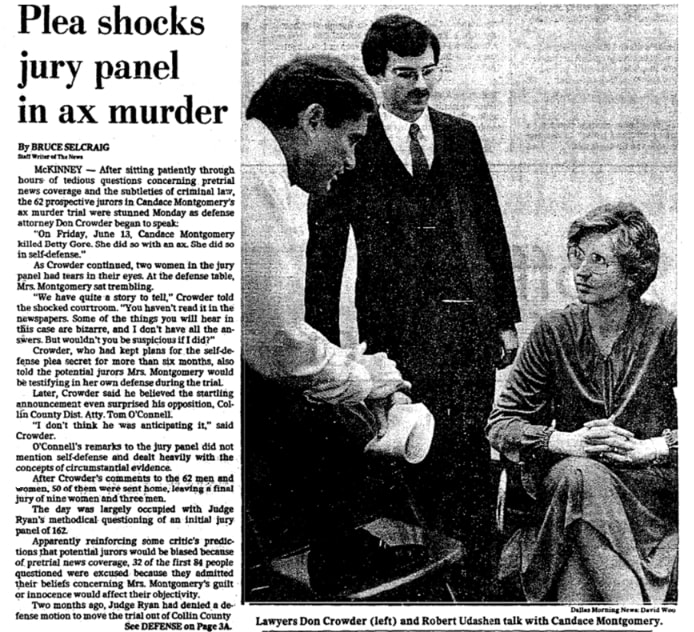Introduction: In this article, James Pylant concludes his story about the bizarre “whodunnit” case of a slaying in small-town Texas. James is an editor at GenealogyMagazine.com and author for JacobusBooks.com, is an award-winning historical true-crime writer, and authorized celebrity biographer.
In 1980, Dallas became television’s highest-rated series with J. R. Ewing’s “whodunnit” shooting. But some 30 miles northeast of Dallas, a grim, true-life “whodunnit” drama unfolded at the Collin County Courthouse in McKinney, Texas.
For eight days in October, spectators crowded the courtroom to hear what the Dallas Morning News called “the ultimate soap opera”: Candace “Candy” Montgomery’s trial for the ax-slaying of her former lover’s wife, Betty Gore.
The pool of prospective jurors for Candy Montgomery’s murder trial were shocked on October 20 when her defense attorney, Don Crowder, admitted she killed Betty Gore – then made a stunning statement.

This article reports:
…the 62 prospective jurors in Candace Montgomery’s ax murder trial were stunned Monday as defense attorney Dan Crowder began to speak:
“On Friday, June 13, Candace Montgomery killed Betty Gore. She did so with an ax. She did so in self-defense.”
As Crowder continued, two women in the jury panel had tears in their eyes. At the defense table, Mrs. Montgomery sat trembling.
“We have quite a story to tell,” Crowder told the shocked courtroom. “You haven’t read it in the newspapers. Some of the things you will hear in this case are bizarre, and I don’t have all the answers. But wouldn’t you be suspicious if I did?”
On October 21 Betty Gore’s husband Allan, called to the stand, testified for nearly three hours with details about his ten-month affair with Candy.
Gore testified that their affair began in December 1978 and ended in October 1979 – eight months before his wife’s death. Gore said Betty and Candy never had an argument, as far as he knew, and he couldn’t think of a possible motive for Candy to kill his wife.
The next day, October 22, three witnesses testified that on the morning of Friday the 13th, Candy finished reading a Bible story to a group of vacation Bible school children at United Methodist Church in Lucas and then left to go to the Gore home in nearby Wylie around 9:30 a.m. One witness recalled seeing Candy return two hours later.
None of the witnesses could recall if Candy had returned to the church wearing different clothing. Everyone agreed Candy seemed calm and emotionally stable upon her return (only hours after the killing), fitting defense attorney Don Crowder’s description of Candy Montgomery as a tough, unemotional woman.
The following day, October 23, was the trial’s emotional climax as the accused took the stand and told a tearful account of her fateful visit to the Gore home.
This article reports:
Candace Montgomery sat motionless on the witness stand, driving her teeth into her lip, clenching her teeth, shutting her eyes to the world and the questions filling the courtroom.
Her eyes swelled with tears and her cheeks glistened as she recalled the morning of June 13 when she and Betty Gore had an argument that led to two minutes of terror.
“I begged her, ‘Betty, please stop, Betty please stop.’”
But Mrs. Gore, a woman Mrs. Montgomery had never seen enraged, grabbed the ax and said only, “Shhh, shhh,” hushing her eerily, Mrs. Montgomery testified.
“I’ve got to kill you,” Mrs. Montgomery remembered hearing Mrs. Gore say.
They fought for the ax, which became slick with the blood of both women during the struggle. Mrs. Montgomery wrestled it loose and swung it once, hitting Mrs. Gore on the right side of her head. Mrs. Gore dropped to the floor.
Mrs. Gore got up as Mrs. Montgomery rushed to the door of the utility room.
“I ran to the utility room door to get out,” Mrs. Montgomery said. “But she threw her body against it. I begged her, ‘Betty, let me go. Betty, let me go.’”
Mrs. Gore slipped on the blood-stained linoleum floor and Mrs. Montgomery grabbed the ax one more time.
“She came rushing at me,” Mrs. Montgomery blurted out.
“Did you know then you’d have to kill her?” her attorney, Don Crowder, asked Mrs. Montgomery.
“I hit her. I hit her. I hit her. And I hit her,” Mrs. Montgomery said, her voice trembling.
“She fell slowly, almost to a sitting position.
“I kept hitting her. And hitting her. I stood back and looked at myself and I was covered in blood.
“I felt so guilty, so dirty. I felt so ashamed.”
Mrs. Montgomery sat on the witness stand, her chest heaving, her face contorted to hold back tears.
Several psychiatrists testified during the trial.
Dallas psychiatrist Dr. Maurice S. Green testified that Candy experienced a “dissociative reaction” to the killing. Candy, he said, “was aware she was hacking Betty Gore to death,” but “everything seemed to be in slow motion… almost like she was a spectator.”
Dr. Fred Fason, a Houston psychiatrist, testified that Candy detailed the deadly confrontation under hypnosis on August 27. Dr. Fason echoed Dr. Green’s opinion about Candy’s dissociated state.
After deliberating for just over three hours, the nine-woman, three-man jury returned a verdict of not guilty. Candy, sitting at the defense table, trembled, clenched her hands in her lap, and stared straight ahead as the verdict was read.
“The ultimate soap opera” mesmerized Hollywood, and Candy appeared on television interpreted by three actresses. In 1990, Barbara Hersey depicted her in “A Killing in a Small Town,” winning Outstanding Lead Actress in a Mini-Series or Special from the Academy of Television Arts & Sciences. The film also received three Emmy Award nominations. Jessica Biel had the starring role in “Candy,” a 2022 Hulu miniseries. Elizabeth Olsen was Candy’s portrayer in the seven-part 1993 HBO Max series “Love & Death.”
All three film depictions were based on the same book, Jim Atkinson and John Bloom’s Evidence of Love: A True Story of Passion and Death in the Suburbs (1984). The authors acknowledged the contributions of Candace Montgomery and Allan Gore. “Both submitted to dozens of hours of interviews” and gave the authors access to letters and diaries.
Explore over 330 years of newspapers and historical records in GenealogyBank. Discover your family story! Start a 7-Day Free Trial
Note on the header image: Sherlock Holmes investigates a mystery.
Illustration credit: https://depositphotos.com/home.html
Related Article:
